2018 PEUGEOT EXPERT child lock
[x] Cancel search: child lockPage 70 of 416

68
Using the button(s) at the front
F To unlock the vehicle and start the
electrically powered opening of a door,
press the button for the corresponding door.
F
P
ressing the button again reverses the
movement of the door.
The button is not operational and pressing
it results in an audible signal, if:
-
t
he vehicle is moving,
-
t
he vehicle has been locked or
deadlocked from outside (using
the key, remote control or Keyless
Entry and Starting, depending on
equipment).
Depending on the equipment you have,
the button for the left-hand door is not
operational and pressing it results in an
audible signal if the fuel filler flap is open.
From inside, selective
unlocking then opening
Using the button(s) at the front
F To unlock only the loading area and start
the electrically powered opening of a door,
press the button for the corresponding door.
F
P
ressing the button again reverses the
movement of the door. The button is not operational and pressing
it results in an audible signal, if:
-
t
he vehicle is moving,
-
t
he vehicle has been locked or
deadlocked from outside (using
the key, remote control or Keyless
Entry and Starting, depending on
equipment).
Depending on the equipment you have,
the button for the left-hand door is not
operational and pressing it results in an
audible signal if the fuel filler flap is open.
From inside, unlocking then
opening
For more information on the Child lock ,
refer to the corresponding section.
Cab
and loading area selectivity
activated.
For more information on the Key, Remote
control or
K
eyless Entr y and Star ting
,
and in particular the total or selective
unlocking, refer to the corresponding
section.
Access
Page 71 of 416
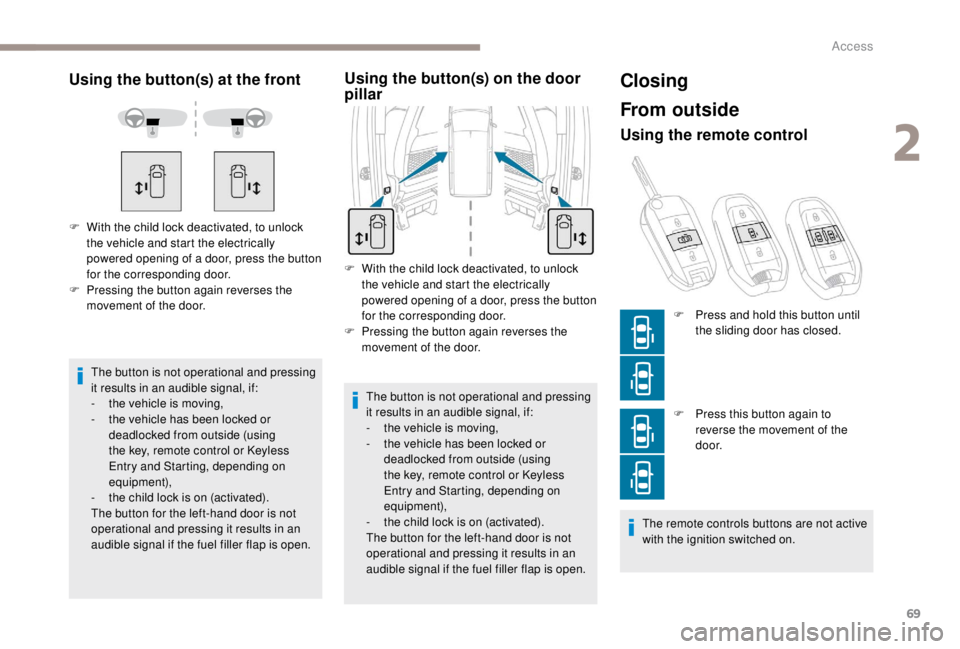
69
Using the button(s) at the front
The button is not operational and pressing
it results in an audible signal, if:
-
t
he vehicle is moving,
-
t
he vehicle has been locked or
deadlocked from outside (using
the key, remote control or Keyless
Entry and Starting, depending on
equipment),
-
t
he child lock is on (activated).
The button for the left-hand door is not
operational and pressing it results in an
audible signal if the fuel filler flap is open.
F
W
ith the child lock deactivated, to unlock
the vehicle and start the electrically
powered opening of a door, press the button
for the corresponding door.
F
P
ressing the button again reverses the
movement of the door.
Using the button(s) on the door
pillar
F With the child lock deactivated, to unlock the vehicle and start the electrically
powered opening of a door, press the button
for the corresponding door.
F
P
ressing the button again reverses the
movement of the door.
The button is not operational and pressing
it results in an audible signal, if:
-
t
he vehicle is moving,
-
t
he vehicle has been locked or
deadlocked from outside (using
the key, remote control or Keyless
Entry and Starting, depending on
equipment),
-
t
he child lock is on (activated).
The button for the left-hand door is not
operational and pressing it results in an
audible signal if the fuel filler flap is open.
Closing
From outside
Using the remote control
F Press this button again to reverse the movement of the
d o o r.
The remote controls buttons are not active
with the ignition switched on. F
P
ress and hold this button until
the sliding door has closed.
2
Access
Page 73 of 416
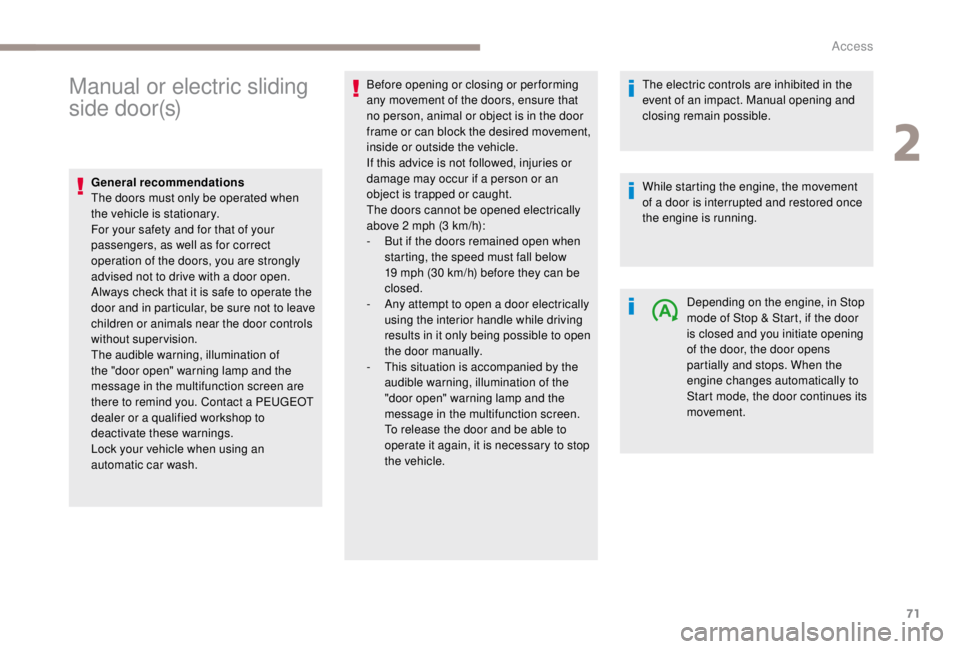
71
Manual or electric sliding
side door(s)
General recommendations
The doors must only be operated when
the vehicle is stationary.
For your safety and for that of your
passengers, as well as for correct
operation of the doors, you are strongly
advised not to drive with a door open.
Always check that it is safe to operate the
door and in particular, be sure not to leave
children or animals near the door controls
without supervision.
The audible warning, illumination of
the "door open" warning lamp and the
message in the multifunction screen are
there to remind you. Contact a PEUGEOT
dealer or a qualified workshop to
deactivate these warnings.
Lock your vehicle when using an
automatic car wash.Before opening or closing or per forming
any movement of the doors, ensure that
no person, animal or object is in the door
frame or can block the desired movement,
inside or outside the vehicle.
If this advice is not followed, injuries or
damage may occur if a person or an
object is trapped or caught.
The doors cannot be opened electrically
above 2
mph (3 km/h):
-
B
ut if the doors remained open when
starting, the speed must fall below
19
mph (30 km/h) before they can be
closed.
-
A
ny attempt to open a door electrically
using the interior handle while driving
results in it only being possible to open
the door manually.
-
T
his situation is accompanied by the
audible warning, illumination of the
"door open" warning lamp and the
message in the multifunction screen.
To release the door and be able to
operate it again, it is necessary to stop
the vehicle. The electric controls are inhibited in the
event of an impact. Manual opening and
closing remain possible.
While starting the engine, the movement
of a door is interrupted and restored once
the engine is running.
Depending on the engine, in Stop
mode of Stop & Start, if the door
is closed and you initiate opening
of the door, the door opens
partially and stops. When the
engine changes automatically to
Start mode, the door continues its
movement.
2
Access
Page 79 of 416
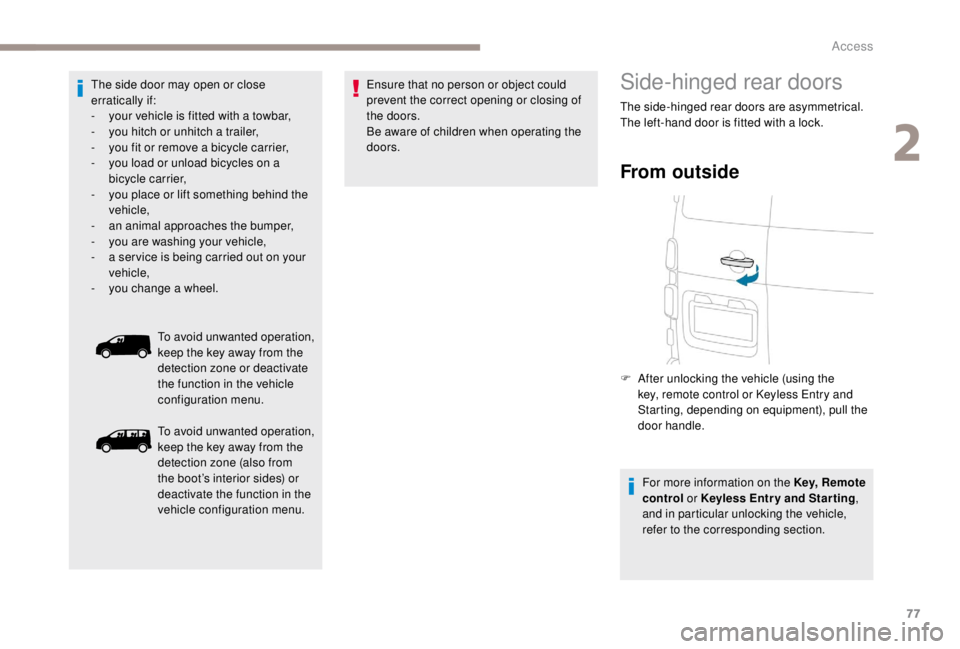
77
The side door may open or close
erratically if:
-
y
our vehicle is fitted with a towbar,
-
y
ou hitch or unhitch a trailer,
-
y
ou fit or remove a bicycle carrier,
-
y
ou load or unload bicycles on a
bicycle carrier,
-
y
ou place or lift something behind the
vehicle,
-
an
animal approaches the bumper,
-
y
ou are washing your vehicle,
-
a s
er vice is being carried out on your
vehicle,
-
y
ou change a wheel. Ensure that no person or object could
prevent the correct opening or closing of
the doors.
Be aware of children when operating the
doors.
To avoid unwanted operation,
keep the key away from the
detection zone or deactivate
the function in the vehicle
configuration menu.
To avoid unwanted operation,
keep the key away from the
detection zone (also from
the boot’s interior sides) or
deactivate the function in the
vehicle configuration menu.Side-hinged rear doors
The side-hinged rear doors are asymmetrical.
The left-hand door is fitted with a lock.
From outside
F After unlocking the vehicle (using the key, remote control or Keyless Entry and
Starting, depending on equipment), pull the
door handle.
For more information on the Key, Remote
control or
K
eyless Entr y and Star ting ,
and in particular unlocking the vehicle,
refer to the corresponding section.
2
Access
Page 81 of 416

79
From inside
Opening
Cab and loading area selectivity
deactivated and vehicle locked.
F
T
wist this handle down to fully unlock the
vehicle and open the right-hand door.
F
T
wist this handle down to unlock the
loading area and open the right-hand door.
F
O
pen the door to the desired position. F
T
wist this handle down to open the right-
hand door.
Vehicle locked. Vehicle locked and child lock off
(deactivated).
F
T
wist this handle down to fully unlock the
vehicle and open the right-hand door.
Vehicle unlocked and child lock
deactivated.
F
T
wist this handle down to open the right-
hand door.
If the child lock is on (activated), the
handle is inoperative.
For more information on the Child lock ,
refer to the corresponding section.
Closing
F First close the right-hand door, then the left- hand door.
Cab
and loading area selectivity
activated and vehicle locked.
Door or vehicle unlocked.
F
T
wist this handle down to fully
unlock the
vehicle and open the right-hand door. Vehicle unlocked.
F
T
wist this handle down to open the right-
hand door.
2
Access
Page 116 of 416
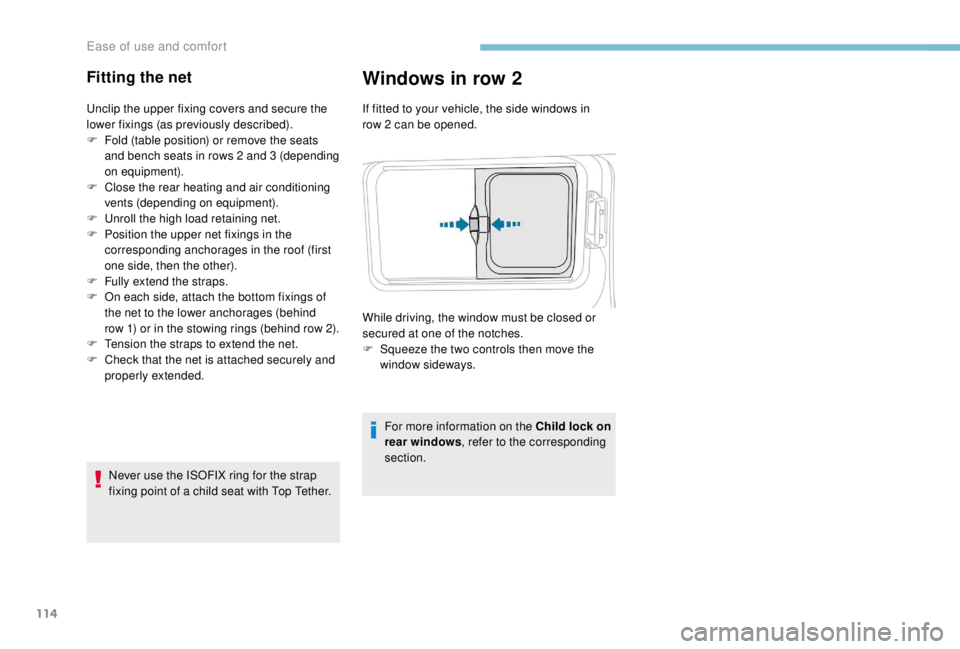
114
Fitting the net
Unclip the upper fixing covers and secure the
lower fixings (as previously described).
F
F
old (table position) or remove the seats
and bench seats in rows 2
and 3 (depending
on equipment).
F
C
lose the rear heating and air conditioning
vents (depending on equipment).
F
U
nroll the high load retaining net.
F
P
osition the upper net fixings in the
corresponding anchorages in the roof (first
one side, then the other).
F
F
ully extend the straps.
F
O
n each side, attach the bottom fixings of
the net to the lower anchorages (behind
row 1) or in the stowing rings (behind row 2).
F
T
ension the straps to extend the net.
F
C
heck that the net is attached securely and
properly extended.
Never use the ISOFIX ring for the strap
fixing point of a child seat with Top Tether.
Windows in row 2
If fitted to your vehicle, the side windows in
row 2 can be opened.
For more information on the Child lock on
rear windows , refer to the corresponding
section.
While driving, the window must be closed or
secured at one of the notches.
F
S
queeze the two controls then move the
window sideways.
Ease of use and comfort
Page 155 of 416
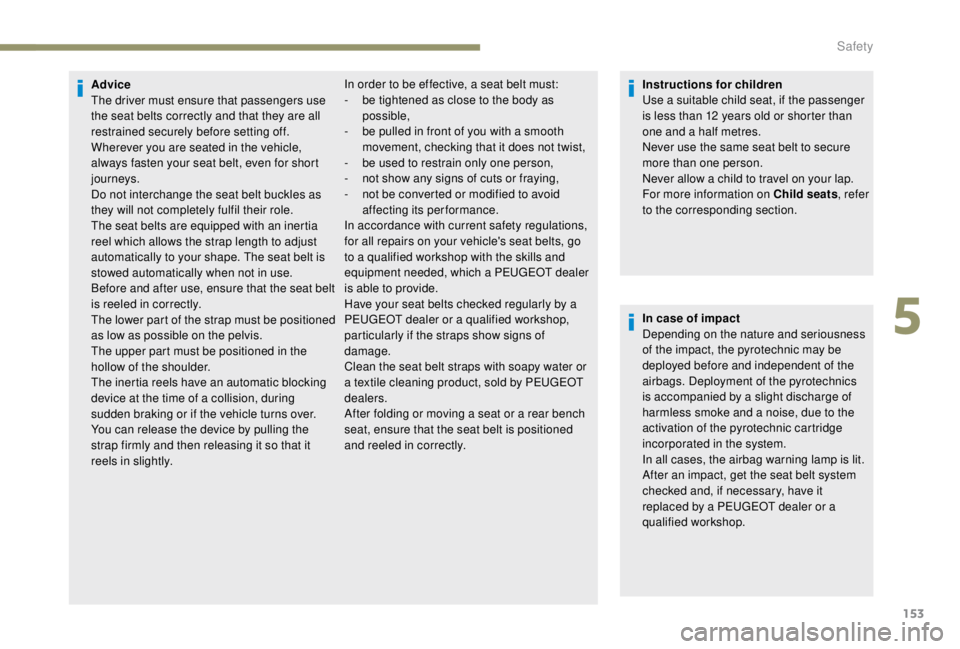
153
Advice
The driver must ensure that passengers use
the seat belts correctly and that they are all
restrained securely before setting off.
Wherever you are seated in the vehicle,
always fasten your seat belt, even for short
journeys.
Do not interchange the seat belt buckles as
they will not completely fulfil their role.
The seat belts are equipped with an inertia
reel which allows the strap length to adjust
automatically to your shape. The seat belt is
stowed automatically when not in use.
Before and after use, ensure that the seat belt
is reeled in correctly.
The lower part of the strap must be positioned
as low as possible on the pelvis.
The upper part must be positioned in the
hollow of the shoulder.
The inertia reels have an automatic blocking
device at the time of a collision, during
sudden braking or if the vehicle turns over.
You can release the device by pulling the
strap firmly and then releasing it so that it
reels in slightly.Instructions for children
Use a suitable child seat, if the passenger
is less than 12
years old or shorter than
one and a half metres.
Never use the same seat belt to secure
more than one person.
Never allow a child to travel on your lap.
For more information on Child seats , refer
to the corresponding section.
In case of impact
Depending on the nature and seriousness
of the impact, the pyrotechnic may be
deployed before and independent of the
airbags. Deployment of the pyrotechnics
is accompanied by a slight discharge of
harmless smoke and a noise, due to the
activation of the pyrotechnic cartridge
incorporated in the system.
In all cases, the airbag warning lamp is lit.
After an impact, get the seat belt system
checked and, if necessary, have it
replaced by a PEUGEOT dealer or a
qualified workshop.
In order to be effective, a seat belt must:
-
b e tightened as close to the body as
possible,
-
b
e pulled in front of you with a smooth
movement, checking that it does not twist,
-
b
e used to restrain only one person,
-
n
ot show any signs of cuts or fraying,
-
n
ot be converted or modified to avoid
affecting its performance.
In accordance with current safety regulations,
for all repairs on your vehicle's seat belts, go
to a qualified workshop with the skills and
equipment needed, which a PEUGEOT dealer
is able to provide.
Have your seat belts checked regularly by a
PEUGEOT dealer or a qualified workshop,
particularly if the straps show signs of
damage.
Clean the seat belt straps with soapy water or
a textile cleaning product, sold by PEUGEOT
dealers.
After folding or moving a seat or a rear bench
seat, ensure that the seat belt is positioned
and reeled in correctly.
5
Safety
Page 175 of 416
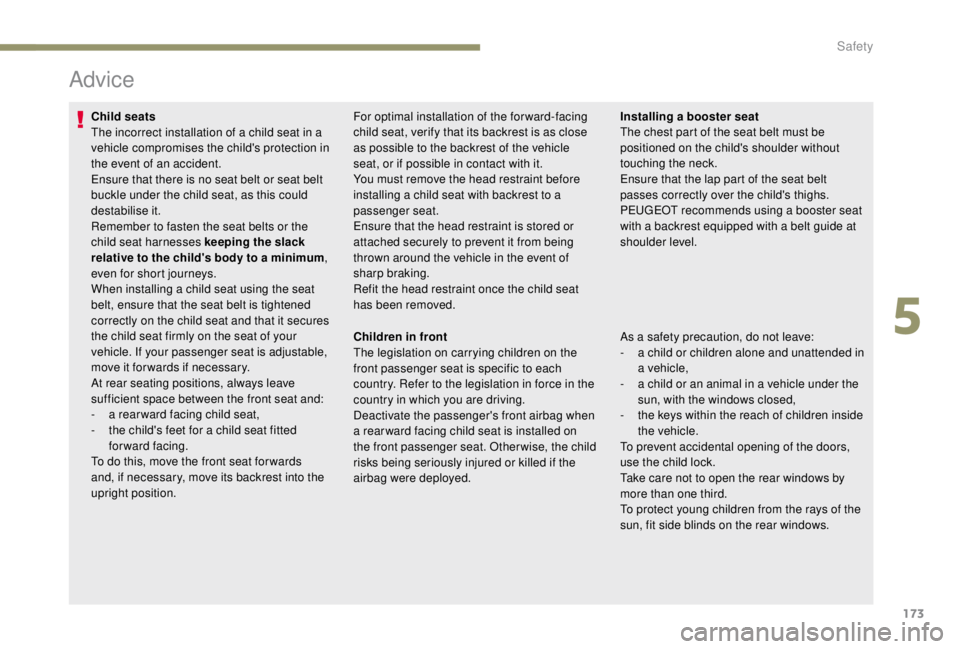
173
Advice
Child seats
The incorrect installation of a child seat in a
vehicle compromises the child's protection in
the event of an accident.
Ensure that there is no seat belt or seat belt
buckle under the child seat, as this could
destabilise it.
Remember to fasten the seat belts or the
child seat harnesses keeping the slack
relative to the child's body to a minimum,
even for short journeys.
When installing a child seat using the seat
belt, ensure that the seat belt is tightened
correctly on the child seat and that it secures
the child seat firmly on the seat of your
vehicle. If your passenger seat is adjustable,
move it for wards if necessary.
At rear seating positions, always leave
sufficient space between the front seat and:
-
a r
ear ward facing child seat,
-
t
he child's feet for a child seat fitted
forward facing.
To do this, move the front seat for wards
and, if necessary, move its backrest into the
upright position. For optimal installation of the forward-facing
child seat, verify that its backrest is as close
as possible to the backrest of the vehicle
seat, or if possible in contact with it.
You must remove the head restraint before
installing a child seat with backrest to a
passenger seat.
Ensure that the head restraint is stored or
attached securely to prevent it from being
thrown around the vehicle in the event of
sharp braking.
Refit the head restraint once the child seat
has been removed.
Children in front
The legislation on carrying children on the
front passenger seat is specific to each
country. Refer to the legislation in force in the
country in which you are driving.
Deactivate the passenger's front airbag when
a rear ward facing child seat is installed on
the front passenger seat. Otherwise, the child
risks being seriously injured or killed if the
airbag were deployed.
Installing a booster seat
The chest part of the seat belt must be
positioned on the child's shoulder without
touching the neck.
Ensure that the lap part of the seat belt
passes correctly over the child's thighs.
PEUGEOT recommends using a booster seat
with a backrest equipped with a belt guide at
shoulder level.
As a safety precaution, do not leave:
-
a c
hild or children alone and unattended in
a vehicle,
-
a c
hild or an animal in a vehicle under the
sun, with the windows closed,
-
t
he keys within the reach of children inside
the vehicle.
To prevent accidental opening of the doors,
use the child lock.
Take care not to open the rear windows by
more than one third.
To protect young children from the rays of the
sun, fit side blinds on the rear windows.
5
Safety